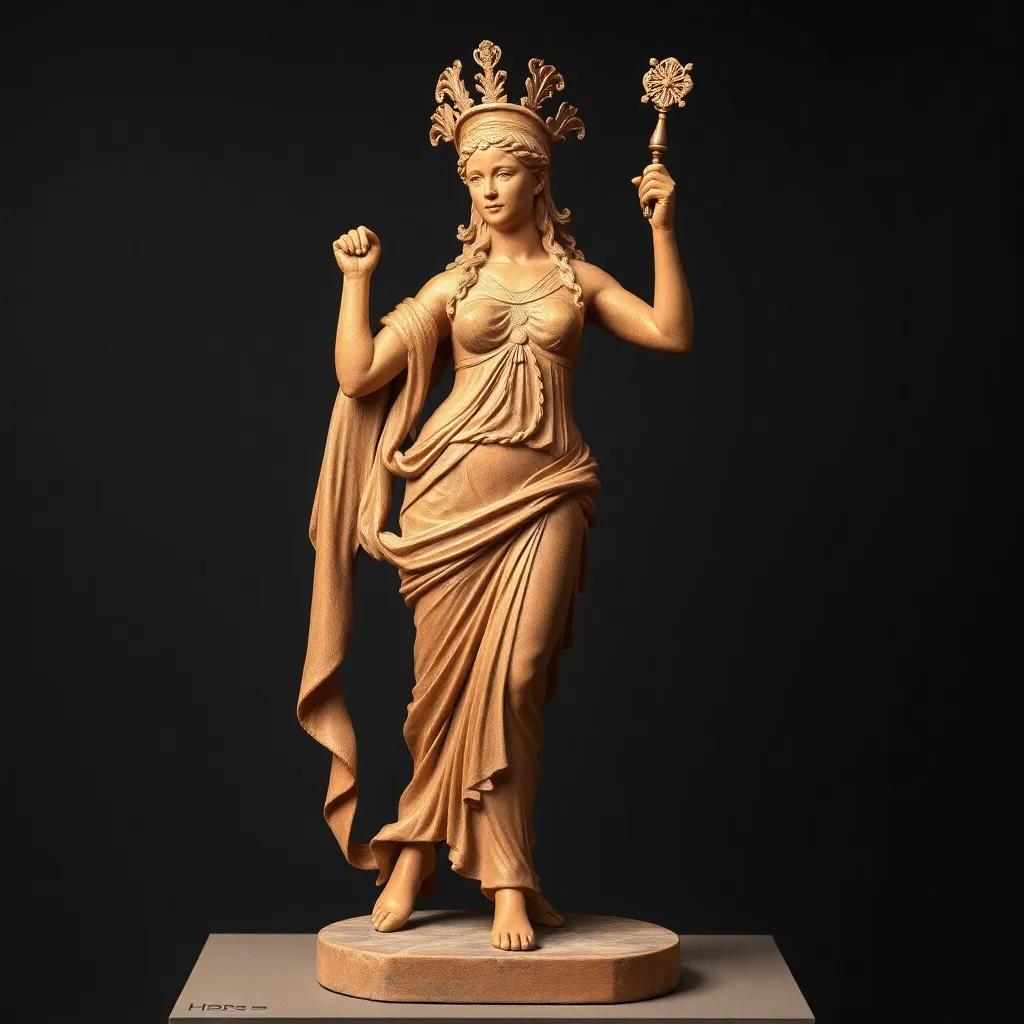The Representation of Hera in Ancient Greek Pottery
I. Introduction
Hera, the queen of the gods in Greek mythology, is a figure of great significance and complexity. Known for her roles as the goddess of marriage and family, she embodies the ideals and challenges faced by women in ancient Greek society. Her character is often depicted with both strength and jealousy, especially in her tumultuous relationship with her husband, Zeus.
Ancient Greek pottery serves as a crucial artifact for understanding the cultural, religious, and artistic expressions of the time. These vessels, often adorned with intricate designs and figures, provide insights into the beliefs and practices of the ancient Greeks. This article aims to examine the representation of Hera in ancient Greek pottery, exploring how these depictions reflect her status in mythology and society.
II. Historical Context of Hera in Greek Mythology
Hera, as one of the twelve Olympian deities, holds a prominent position in the Greek pantheon. She is often associated with marriage, childbirth, and the protection of women. Her significance is underscored by her role as the wife of Zeus and the mother of several gods, including Ares, Hephaestus, and Hebe.
Common myths involving Hera illustrate her dual nature: she is both a devoted wife and a vengeful goddess. Notable stories include:
- The Judgement of Paris, where Hera, along with Athena and Aphrodite, competes for the title of the fairest.
- Her relentless pursuit of vengeance against Zeus’s lovers and their offspring, particularly Heracles.
- The story of her nurturing and protective role over women during childbirth.
Hera’s relationships with other gods and mortals further complicate her character. Her rivalry with Zeus often leads to dramatic confrontations, showcasing her strength and agency within the patriarchal structure of mythology.
III. The Evolution of Pottery Styles in Ancient Greece
Ancient Greek pottery evolved through several distinct styles, each reflecting cultural and artistic shifts. The major pottery styles include:
- Geometric: Characterized by abstract patterns and figures, this style emerged around 900 BCE.
- Black-Figure: Developed in the 7th century BCE, this technique featured black figures against a red background, allowing for detailed representations.
- Red-Figure: Emerging in the late 6th century BCE, this style inverted the black-figure technique, enabling greater flexibility in depicting intricate details.
These styles not only reflect artistic innovation but also the changing societal values and influences of the time. Pottery served both practical and ceremonial purposes, from everyday use to significant religious rituals.
IV. Iconography of Hera in Pottery
Hera is frequently depicted with specific symbols and attributes that convey her identity and divine status. Common motifs associated with her include:
- Peacock: A symbol of beauty and pride, often accompanying Hera in artistic representations.
- Diadem: Signifying her royal status as queen of the gods.
- Throne: Representing her authority and power.
Analysis of specific pottery pieces reveals various ways Hera is portrayed across different styles. For instance, in black-figure pottery, she may be shown seated on a throne, while in red-figure pottery, more dynamic scenes depict her interactions with other deities.
Variations in representation highlight the regional and temporal differences in worship and artistic focus, illustrating how Hera’s image evolved alongside societal changes.
V. Hera’s Representation in Domestic vs. Public Contexts
Hera’s depictions vary significantly between domestic and public contexts. In domestic pottery, such as kraters and kylixes, she is often portrayed in scenes related to marriage and family, emphasizing her role as a protector of the household. These vessels were typically used in symposiums or family gatherings, reflecting her importance in domestic life.
Conversely, in public art and temple decorations, Hera’s representation often emphasizes her divine authority and grandeur. Temples dedicated to Hera, such as the Heraion of Olympia, feature elaborate sculptures and friezes that celebrate her power and status among the gods.
The context of these representations is crucial to understanding Hera’s role in both everyday life and religious practices.
VI. Comparative Analysis: Hera and Other Deities
When comparing Hera to other goddesses, such as Athena and Artemis, several similarities and differences emerge. Like Athena, Hera is a powerful female figure, yet their realms of influence differ significantly. Athena embodies wisdom and warfare, while Hera is primarily associated with marriage and family.
Hera’s portrayal in relation to male gods, particularly Zeus, also reveals interesting dynamics. While she is depicted as a formidable goddess, her narratives often revolve around her struggles against Zeus’s infidelities, highlighting the complexities of female power within a patriarchal framework.
This comparative iconography offers valuable insights into the broader themes of gender and power in ancient Greek mythology.
VII. The Role of Hera in Rituals and Ceremonies
Pottery played a significant role in religious rituals involving Hera. Vessels used in ceremonies often depicted scenes of worship, sacrifice, and offerings made to the goddess. For instance, kraters might illustrate the pouring of libations in Hera’s honor during marriage ceremonies.
Depictions of Hera in scenes of worship highlight her importance in ancient Greek religious practices. These representations serve as a reminder of the cultural significance placed on the goddess and the rituals performed in her name, emphasizing her role in the lives of the ancient Greeks.
VIII. Conclusion
This exploration of Hera’s representation in ancient Greek pottery reveals her multifaceted role within mythology and society. Through various artistic styles and contexts, Hera emerges as a complex character who embodies both the ideals and challenges faced by women in ancient Greece.
The depictions of Hera not only reflect the artistic values of the time but also provide a window into the cultural and religious practices of ancient Greek society. Further research into Hera and other mythological figures could deepen our understanding of how art and mythology intertwine, revealing the rich tapestry of ancient Greek life.




